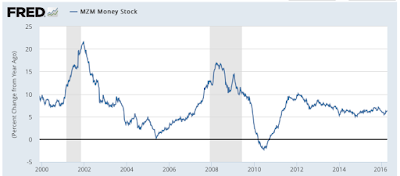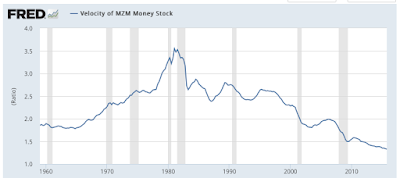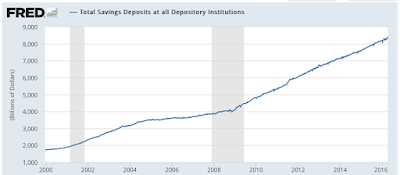This article was last updated on April 16, 2022
Canada: ![]() Oye! Times readers Get FREE $30 to spend on Amazon, Walmart…
Oye! Times readers Get FREE $30 to spend on Amazon, Walmart…
USA: ![]() Oye! Times readers Get FREE $30 to spend on Amazon, Walmart…
Oye! Times readers Get FREE $30 to spend on Amazon, Walmart…
Anyone who has been awake and paying attention since 2007 realizes that the "printing presses" at the Federal Reserve have been operating full-time in a desperate attempt to stave off both another Great Depression and the next recession. The Fed's actions have led to this expansion in MZM:
MZM stands for Money Zero Maturity and includes the liquid money supply in the economy, representing all of the M2 money (cash plus savings deposits) minus time deposits (i.e. certificates of deposit) plus all money market funds. In other words, MZM is a measure that shows us how much money is readily available in the economy for spending and consumption.
Here's what the year-over-year expansion in MZM looks like since 2000:
You can clearly see the expansions in MZM just prior to, during and immediately after a recession as the Fed attempts to stave off economic slowdowns. What is unusual about the current economic expansion is the length of time that MZM has experienced annual growth above five percent; over the five year period since April 2011, MZM has grown between five and ten percent on an annual basis. After the recession in 2001, MZM annual growth dropped to less than five percent within two years after that recession.
Let's switch gears for a moment and look at the velocity of MZM. For those of you who are not aware of the concept of the velocity of money, it is a measure of the rate at which money is exchanged from one transaction to another. In other words, it measures the rate at which the money in circulation is used for purchasing goods and services or the number of times an average unit of currency is used to purchase goods and services within a given period of time. The Federal Reserve defines the velocity of money as the ratio of nominal gross domestic product to the supply of money. The Fed also uses this equation:
MV = PQ
where M stands for money, V stands for the velocity of money, P stands for the general price level and Q stands for the quantity of goods and services produced. Based on this equation, with money velocity being constant, if the supply of money rises at a faster rate than real economic output, then the price level must rise to make up the difference (i.e. inflation can occur).
This equation can also be manipulated to look like this:
V = PQ/M
In this form, the equation can be used to give us a sense of the economy's strength aka people's willingness to spend money. Given a constant supply of money or a supply of money that is growing at a rate that is slower than the rate of economic growth, where there are more transactions (i.e. an economic expansion), the velocity of money rises and where there are fewer transactions (i.e. an economic contraction), the velocity of money declines.
Now that we have all of that behind us, let's look at what has happened to the velocity of MZM going back to the late 1950s:
Despite the Fed's prodding and the so-called economic expansion, in fact, the velocity of money has reached its lowest point since the late 1950s. Obviously, the Fed's massive money injections (M in the equation) since 2008 have not accomplished even a one-for-one proportional increase in nominal GDP (either P or Q in the equation).
Why did the increase in MZM not cause a proportional increase in either price or quantity of goods and services produced? Here's at least part of the answer:
Please keep in mind that the banking sector is not required to hold excess reserves and that prior to late 2008, excess reserves stood at essentially zero since there was no incentive to hold excess reserves at the Federal Reserve. However, thanks to the Fed's newfound wisdom of paying interest on excess reserves (IOER) of 0.25 percent starting in December 2008 and 0.50 percent starting in December 2015, the banking sector would rather leave nearly $2.4 trillion of that "newly minted cash" sitting risk-free at the Fed than taking a risk and lending it to individuals and businesses. In other words, the Federal Reserve is rewarding banks for doing exactly what they didn't want them to do in the first place.
Another aspect that has negatively impacted the velocity of money is consumer spending which has done this on a year-over-year basis:
Over the post-Great Recession period, annual growth in personal consumption expenditures has been at its lowest level going back to the 1960s. Despite all of that "money" that has been injected into the economy, consumers simply aren't feeling as secure as they did during the other economic expansions of the past fifty plus years. Perhaps at least some of this lack of spending is due to the fact that the Fed's ultra-low interest rate policies have meant that there have been negligible returns on low-risk investments like certificates of deposit and Treasuries meaning that people (particularly retirees and those close to retirement) have had to save more as shown on this graph:
Since the end of 2008, savings deposits have increased by $4.2 trillion with year-over-year increases of between 4.7 percent and 18.9 percent.
Thanks to the banking sector and its cash-hoarding habits and consumers that have felt little confidence in their futures, the economy has been spared a very painful bout of inflation. Despite the fact that things have not gone the way that they should have given the Fed's massive injection of "cash" into the economy, the ultra-low level of the velocity of money has been good for one thing, another in a long line of unintended consequences of questionable monetary policy.
Click HERE to read more of Glen Asher's columns
You can publish this article on your website as long as you provide a link back to this page.







Be the first to comment